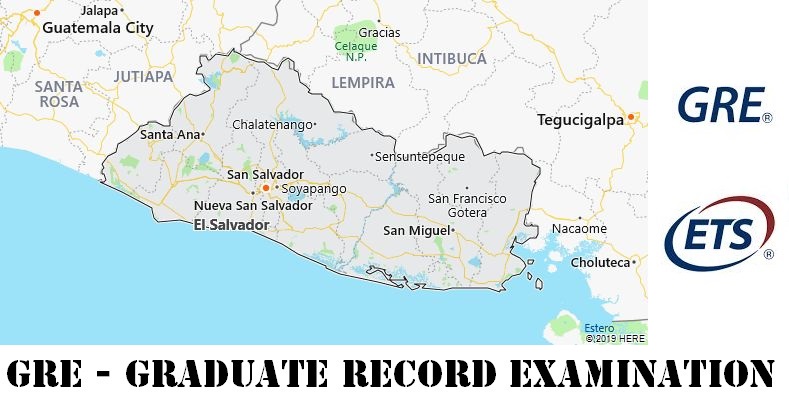GRE Testing Locations
Decided to take GRE exam? Now it is time to determine where to take the test. This site provides a full list of GRE testing centers in El Salvador, among which, you can choose one that is nearest to you. Good news is that the following GRE test locations in El Salvador offer both GRE general test and the GRE subject tests.
Paper-delivered Test Centers for General Test
| Code | Name |
| 10579 | San Salvador, CENTRO CULT. SALVADORENO AMERICANO |
GRE Test Dates
There are two types of test format offered by the test maker – ETS: Computer-delivered and Paper-delivered GRE general tests. For computer based test format, the GRE General Test is offered year-round on a continuous basis, and available for registration on a first-come, first-served basis. For paper based general test, testing is available three times per year. The following test dates apply:
| Test Dates for Paper Based | Deadlines for Registration | Scores Available |
|---|---|---|
| November 09, 2019 | October 4, 2019 | December 20, 2019 |
| February 1, 2020 | December 27, 2019 | March 13, 2020 |
GRE Subject Tests in El Salvador
The GRE Subject Tests are available on paper based only. In all GRE test centers throughout the world (both inside and outside United States), the exam is available three times a year. The three test dates are:
- April
- September
- October

More about El Salvador
TRADITIONS
The majority made up of mestizos are flanked by pure Indians and the small but dominant minority of Creoles, who descend from the conquering Spaniards and make up the ruling caste of the nation. In the country, which is somewhat affected by North American models, traditions that have survived intact even through the most ancient Christianization in the intact nuclei of the Indians (in Panchimalco, Izalco, Nahuizalco, etc., in the inaccessible and remote areas of the interior). They are more fully expressed in ceremonies and religious festivals, enlivened by dances and music performed with instruments (pito de cana, chirimía, flautilla de los sacrificios) of pre-Columbian origin; often, in the houses, amulets and bunches of dried herbs are placed side by side with the images of the Madonna or of saints; major Christian holidays such as the Día de la Cruz, the Día de las Indias or like that of Salvador do Mundo, celebrated in the capital between July 24 and August 6, constitute a synthesis of ancient and new rites. Elements of pre-Columbian ancestry remain among the more conservative populations in the rites that accompany birth or in the beliefs that regulate female life, which is tiring and difficult because many jobs are still entrusted to women. Among the indie minorities, where the taxtuler (figure halfway between the minstrel and the sorcerer) summarizes for the occasion the functions of the mayor and the priest, particularly lively and complex is the celebration of the marriage rite, which the entire village participates in with overwhelming parties of two or three days. Popular housing is characterized by very poor materials and shapes, with essential furnishings and tools, including metate, a very ancient millstone. Among the original foods there are numerous dishes based on corn, others with beans, the mazahuata (sliced and fried snake). From the ground and fermented corn also derive chicha, the most popular drink, and chilate (a beer made from green corn); other drinks: guaro (cane brandy), the tiste of chocolate and the refrescos of lemon and tamarind. The basic color of the clothing is white: a blouse with embroidered collar and sleeves, an ankle- length skirt (enagua) with gathered flounces, sandals, a shawl (rebozo) and colored necklaces for women; in the typical men’s clothing it is the hat, made of straw or palm leaves, with a low dome. The craft activity focuses on the production of wicker baskets, mats and hats, earthenware and containers made up of pumpkins, often decorated in bright colors.
CULTURE
Located in an area where different presences (Olmecs, Mayans, Aztecs) alternated already in pre-Columbian times, El Salvador has been able to welcome and keep traces of every culture with which it has come into contact, up to the recent American influence. The archaeological sites (of which many artifacts are on display at the Museo Nacional of the capital) testify to remote anthropization: among all the site of Tazumal, where many artifacts have yet to be unearthed, and Joya de Cerén, not far from San Salvador, entered since 1993 in the World heritage list drawn up by ‘ UNESCO. Between the mountains and the plateaus, in the numerous villages that have been preserved over the centuries, the Indians still manage to live according to their original customs, except for having made their own some aspects of the peoples who came from afar. Thus, it is not uncommon to witness religious expressions resulting from a true syncretism between remote beliefs and cults and imported Christian practices. On the other hand, the artistic and literary expressions of El Salvador are mainly indebted to the Spanish influence, while only after the end of the civil war did the country begin to open up to the world also from a cultural point of view. The most important institutions in this sense are the Central American University, founded by the Jesuits, which is only one of the universities present in the capital and which was a reference point during the civil war,

